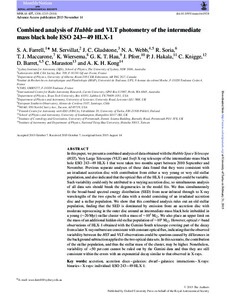Combined analysis of Hubble and VLT photometry of the intermediate mass black hole ESO 243-49 HLX-1
A. K. H. Kong; C. Maraston; M. Servillat; R. Soria; C. Knigge; P. J. Hakala; J. Pforr; S. A. Farrell; J. C. Gladstone; K. Wiersema; D. Barret; T. J. Maccarone; N. A. Webb; G. K. T. Hau
https://urn.fi/URN:NBN:fi-fe2021042715164
Tiivistelmä
In this paper, we present a combined analysis of data obtained with the Hubble Space Telescope (HST), Very Large Telescope (VLT) and Swift X-ray telescope of the intermediate-mass black hole ESO 243-49 HLX-1 that were taken two months apart between 2010 September and November. Previous separate analyses of these data found that they were consistent with an irradiated accretion disc with contribution from either a very young or very old stellar population, and also indicated that the optical flux of the HLX-1 counterpart could be variable. Such variability could only be attributed to a varying accretion disc, so simultaneous analysis of all data sets should break the degeneracies in the model fits. We thus simultaneously fit the broad-band spectral energy distribution (SED) from near-infrared through to X-ray wavelengths of the two epochs of data with a model consisting of an irradiated accretion disc and a stellar population. We show that this combined analysis rules out an old stellar population, finding that the SED is dominated by emission from an accretion disc with moderate reprocessing in the outer disc around an intermediate-mass black hole imbedded in a young (˜20 Myr) stellar cluster with a mass of ˜105 M&sun;. We also place an upper limit on the mass of an additional hidden old stellar population of ˜106 M&sun;. However, optical r'-band observations of HLX-1 obtained with the Gemini-South telescope covering part of the decay from a later X-ray outburst are consistent with constant optical flux, indicating that the observed variability between the HST and VLT observations could be spurious caused by differences in the background subtraction applied to the two optical data sets. In this scenario, the contribution of the stellar population, and thus the stellar mass of the cluster, may be higher. Nonetheless, variability of <50 per cent cannot be ruled out by the Gemini data and thus they are still consistent within the errors with an exponential decay similar to that observed in X-rays.
Kokoelmat
- Rinnakkaistallenteet [19250]
